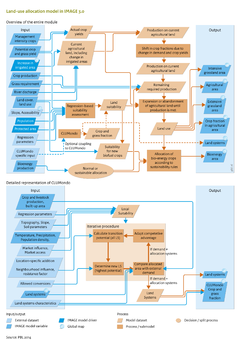Land-use allocation/Policy issues: Difference between revisions
Jump to navigation
Jump to search
No edit summary |
No edit summary |
||
| Line 1: | Line 1: | ||
{{ComponentPolicyIssueTemplate | {{ComponentPolicyIssueTemplate | ||
|Description=In a baseline scenario, agricultural area increases at the expense of forest and other natural areas (for instance, [[PBL, 2012]]). The land-use allocation model is used to indicate where these changes may occur | |Description=In a baseline scenario, agricultural area increases at the expense of forest and other natural areas (for instance, [[PBL, 2012]]). The land-use allocation model is used to indicate where these changes may occur. Thus, it helps to assess the consequence of agricultural expansion and intensification in specific ecosystems. | ||
|Example=The policy interventions that can be analysed are related to either the agricultural economy ([[Agricultural economy]]), or they are reflected in the allocation rules used in the land-use allocation module (e.g. more protected areas, {{AbbrTemplate|REDD+}} schemes). In a study using the OECD Environmental Outlook scenario, the model was used to evaluate impacts of protection levels of natural areas: on top of a baseline scenario with strong bioenergy mandates, it was assumed that 20% (Prot20) of 50% (Prot50) of the land area were protected as nature reserves, or that all forest and woodland was protected from agricultural expansion (see figure below). The relative reduction in land use and CO<sub>2</sub> emissions differ greatly depending on the type of areas protected. If forests are protected, almost the same amount of agricultural land is used by switching to non-forested land. Thus CO<sub>2</sub> emissions are reduced, but reduction in land use and related biodiversity loss is much less. | |Example=The policy interventions that can be analysed are related to either the agricultural economy ([[Agricultural economy]]), or they are reflected in the allocation rules used in the land-use allocation module (e.g. more protected areas, {{AbbrTemplate|REDD+}} schemes). In a study using the OECD Environmental Outlook scenario, the model was used to evaluate impacts of protection levels of natural areas: on top of a baseline scenario with strong bioenergy mandates, it was assumed that 20% (Prot20) of 50% (Prot50) of the land area were protected as nature reserves, or that all forest and woodland was protected from agricultural expansion (see figure below). The relative reduction in land use and CO<sub>2</sub> emissions differ greatly depending on the type of areas protected. If forests are protected, almost the same amount of agricultural land is used by switching to non-forested land. Thus CO<sub>2</sub> emissions are reduced, but reduction in land use and related biodiversity loss is much less. | ||
}} | }} | ||
Revision as of 13:48, 20 November 2016
Parts of Land-use allocation/Policy issues
| Component is implemented in: |
| Components: |
| Related IMAGE components |
| Projects/Applications |
| Key publications |
